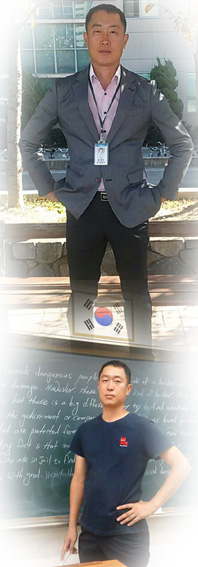2011학년도 수능 외국어 영역 27번 정답 및 해설 - 송곡닷컴(songgok.com)
27. 다음 빈칸에 들어갈 말로 가장 적절한 것을 고르시오.
Psychologist Solomon Asch wanted to discover whether people’'s tendency to agree with their peers was stronger than their tendency toward independent thought and rational judgment. Asch assembled groups of twelve university students and announced that they were taking part in an experiment on visual perception. He showed them three line segments, and asked each one in turn which line was the longest. It was an easy task and the correct answer was obvious. However, Asch had secretly instructed all but the last person in each group, who was the real subject of the experiment, to say that the medium-length line was the longest. As it turned out, over 70 percent of the real subjects and said that the medium-length line was the longest.
① caved in to group pressure
② figured out the correct answer
③ had problems with their vision
④ roped the other group members in
⑤ used rational judgment in their decision-making
1. 내용풀이
사람들이 독립적인 사고와 이성적인 판단보다는 동료들에게 동의하려는 성향이 더 강하다는 것을 실험한 내용이므로, 빈칸에는 ‘집단의 압력에 굴복했다’가 가장 적절함. ② 정답을 이해했다, ③ 시력에 문제가 있었다, ④ 다른 집단의 일원을 끌어들였다, ⑤ 의사결정에 있어서 이성적인 판단을 사용했다
2. 구문해설
[Psychologist Solomon Asch wanted to discover whether people’'s tendency to agree with their peers was stronger than their tendency toward independent thought and rational judgment]
* 이 지문에서 비교 대상은 성향(tendency)입니다. 즉 [people's tendency to agree with their peers](동료들의 뜻에 따르려는 사람들의 성향) 과 [their tendency toward independent thought and rational judgment](독립적인 사고와 이성적인 판단을 하려는 사람들의 성향)..그러면 여기서 글의 흐름을 짐작할 수 있겠지요..?
→→→심리학자 Solomon Asch는 사람들의 독립적인 사고(independent thought)와 이성적인 판단(rational judgment)에 대한 성향 보다 동료들에게 동의하려는 성향(tendency to agree with their peers)이 더 강한지 어떤지를 알고 싶었다.
[Asch assembled groups of twelve university students and announced that they were taking part in an experiment on visual perception]
→→→ Asch는 20명의 대학생들로 이루어진 집단들(groups of twelve university students)을 모아서, 그들이 시각적 지각(visual perception)에 관한(on) 실험에 참여하고 있다고 알렸다.
[He showed them three line segments, and asked each one in turn which line was the longest. It was an easy task and the correct answer was obvious]
→→→그는 그들에게 줄 세 조각(three line segments)을 보여주고서 차례대로(in turn) 어느 줄이 가장 긴지(which line was the longest)를 각자(each one)에게 물었다. 그것은 쉬운 일이었고 정답은 명백했다.
[However, Asch had secretly instructed all (but the last person in each group, who was the real subject of the experiment,) to say that the medium-length line was the longest]
* instruct Ⓐ to Ⓑ: Ⓐ에게 Ⓑ하도록 지시하다. * but: ~을 제외하고 * all but: ~을 제외하고 모두 * the last person in each group, who was the real subject = the last person in each group, for he was the real subject→관계대명사 계속적 용법(접속사 + 대명사) 아시죠..? (왜냐하면 그가 진짜 피실험자였기 때문에)
→→→하지만, Asch는 (그 실험의 실제 피(被)실험자였던) 각 집단의(in each group) 마지막 사람(the last person)을 제외한(but) 모든 사람들에게 은밀히 중간 길이의 줄이 가장 길다고(the medium-length line was the longest) 말하도록 지시했다
[As it turned out, over 70 percent of the real subjects caved in to group pressure and said that the medium-length line was the longest] *As it turned out:입증된 것처럼(밝혀진 것처럼) *turn out: 판명되다, 입증되다 *cave in: ~에 굴복하다.
→→→나중에 밝혀진 것처럼(As it turned out) 실제 피(被)실험자의 70퍼센트 이상이(over 70 percent of the real subjects) 집단의 압력에 굴복해서(caved in to group pressure) 중간 길이의 줄이 가장 길다고 말했다
3. 단어정리
*Psychologist 심리학자 *tendency 경향, 성향 *peer 동료 *independent 독립적인 *rational 이성적인 *judgment 판단 *assemble 모으다, 집합시키다, 소집하다 *visual perception 시각적 지각(인식) *segment 조각, 단편 *obvious 명백한 *secretly 비밀로, 몰래 *instruct 지시하다 * instruct Ⓐ to Ⓑ: Ⓐ에게 Ⓑ하도록 지시하다 *but: ⓵그러나 ⓶~을 제외하고 ⓷ 단지(only) ⓸ that~not *subject 피(被)실험 자, 실험 대상자 *as it turned out 나중에 밝혀진 것처럼, 뒤에 알고 보니 *cave in to ~에 응하다, ~에 굴복하다*figured out:~을 이해하다 *rope ~ in: ~을 끌어 들이다 *decision-making: 의사결정
4. 전문해석
심리학자 Solomon Asch는 사람들이 독립적인 사고와 이성적인 판단에 대한 성향 보다 동료들에게 동의하려는 성향이 더 강한지 어떤지를 알고 싶었다. Asch는 20명의 대학생들로 이루어진 집단들을 모아서, 그들이 시각적 지각에 관한 실험에 참여 할 거라고 알렸다. 그는 그들에게 줄 세 조각을 보여주고서 차례대로 어느 줄이 가장 긴지를 각자에게 물었다. 그것은 쉬운 일이었고 정답은 명백했다. 하지만, Asch는 그 실험의 실제 피(被)실험자에 해당하는 각 집단의 마지막 사람을 제외한 모든 사람들에게 은밀히 중간 길이의 줄이 가장 길다고 말하도록 지시했다. 나중에 밝혀진 것처럼 실제 피(被)실험자의 70퍼센트 이상이 집단의 압력에 굴복해서 중간 길이의 줄이 가장 길다고 말했다.
.gif)

.gif)
